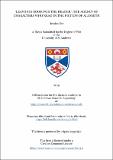Files in this item
‘Leav(ing) room for the reader’ : the agency of characters who read in the fiction of Ali Smith
Item metadata
| dc.contributor.advisor | Sellers, Susan | |
| dc.contributor.author | Orr, Jessica | |
| dc.coverage.spatial | [6], 266 p. | en_US |
| dc.date.accessioned | 2019-11-01T14:32:31Z | |
| dc.date.available | 2019-11-01T14:32:31Z | |
| dc.date.issued | 2019-12-04 | |
| dc.identifier.uri | https://hdl.handle.net/10023/18826 | |
| dc.description.abstract | This thesis argues that characters who read are a recurring preoccupation in the work of contemporary Scottish writer Ali Smith, who foregrounds the act of reading as equal to, if not more important than, the act of writing itself. It begins by examining aspects of Smith’s own personal history as a reader, and establishing a critical framework for understanding this identification through two reader-response perspectives: Louise Rosenblatt’s ‘The Reader, The Text, The Poem’ and Wolfgang Iser’s ‘The Act of Reading’. These ideas counterpoint portrayals of reading as a passive and subordinate activity, as propagated by schools of thinking such as the New Criticism, and transform it into one of agency and participation. The three following chapters further evidence this re-conceptualisation of the reader’s role, drawing on different critical perspectives to examine more nuanced aspects of Smith’s representation. Firstly, ‘The Embodied Reader’ considers the – often explosive - physicality of the reader’s experience in the novels ‘Like’ and ‘Autumn’, drawing on three key essays by the feminist critic Hélène Cixous: ‘Sorties: Out and Out: Attacks/Ways Out/Forays’, ‘Difficult Joys’ and ‘Coming to Writing’, which similarly conceptualise reading and writing as visceral activities driven by bodily impulses and desires. Secondly, ‘The Dialogic Reader’ focusses on readers’ narrative interventions in ‘Artful’ and several of Smith’s short stories, drawing on Mikhail Bakhtin’s concept of dialogism in his essay ‘Discourse in the novel’ to suggest that the disruptive voice of the reader works to challenge the prevailing authority of the text. Thirdly, ‘The Reader as a Spectator’ considers characters who engage with contemporary visual technologies as part of a broader conception of who might be considered a ‘reader’ in Smith’s work. Supported by critical perspectives such as Laura Mulvey’s ‘Death 24x a Second’ and Mary Ann Doane’s ‘The Emergence of Cinematic Time’, this chapter argues that the adolescent protagonists of ‘The Accidental’ and ‘How to be both’ are encouraged to take similar control over what they see, as with what they read. | en_US |
| dc.language.iso | en | en_US |
| dc.publisher | University of St Andrews | |
| dc.rights | Creative Commons Attribution 4.0 International | * |
| dc.rights.uri | http://creativecommons.org/licenses/by/4.0/ | * |
| dc.subject | Reader response | en_US |
| dc.subject | Ali Smith | en_US |
| dc.subject | Scottish literature | en_US |
| dc.subject | Embodied | en_US |
| dc.subject | Dialogic | en_US |
| dc.subject | Spectator | en_US |
| dc.subject | Contemporary literature | en_US |
| dc.subject.lcc | PR6069.M56Z5O8 | |
| dc.subject.lcsh | Smith, Ali, 1962- --Criticism and interpretation | |
| dc.subject.lcsh | Books and reading in literature | en |
| dc.subject.lcsh | Reader-response criticism | en |
| dc.title | ‘Leav(ing) room for the reader’ : the agency of characters who read in the fiction of Ali Smith | en_US |
| dc.type | Thesis | en_US |
| dc.contributor.sponsor | Arts and Humanities Research Council (AHRC) | en_US |
| dc.contributor.sponsor | Scottish Graduate School for Arts and Humanities (SGSAH) | en_US |
| dc.type.qualificationlevel | Doctoral | en_US |
| dc.type.qualificationname | PhD Doctor of Philosophy | en_US |
| dc.publisher.institution | The University of St Andrews | en_US |
| dc.identifier.doi | https://doi.org/10.17630/10023-18826 |
The following licence files are associated with this item:
This item appears in the following Collection(s)
Except where otherwise noted within the work, this item's licence for re-use is described as Creative Commons Attribution 4.0 International
Items in the St Andrews Research Repository are protected by copyright, with all rights reserved, unless otherwise indicated.


